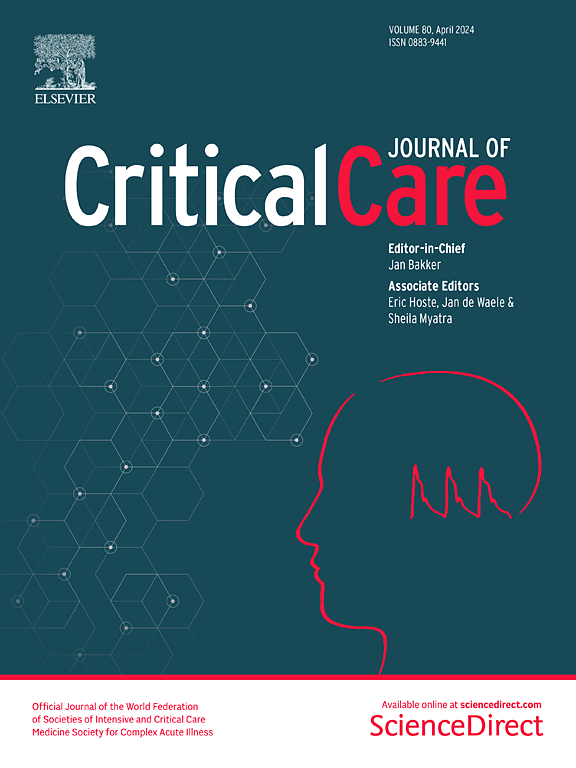静脉体外膜氧合中的血液创伤:低泵压和低回路阻力很重要
IF 8.8
1区 医学
Q1 CRITICAL CARE MEDICINE
引用次数: 0
摘要
静脉体外膜氧合(VV ECMO)已成为治疗最严重急性呼吸窘迫综合征患者的标准疗法。然而,溶血和出血是最常见的副作用之一,会影响死亡率。尽管 VV ECMO 得到了广泛应用,但目前的方案缺乏详细的、基于体内数据的安全 ECMO 泵操作条件建议。本研究旨在通过结合体内建模和临床数据分析,全面分析 VV ECMO 泵操作条件对溶血的影响。我们将 580 名接受 VV ECMO 治疗的患者的数据与利用计算流体动力学和 Rotaflow(Getinge)和 DP3(Xenios)泵的降阶建模对溶血进行的数值预测相结合。94,779个泵工作点的血液创伤参数与剪切诱导溶血的数值预测结果相关联。在低泵压和低回路阻力条件下,所有流速下的溶血量都极小,而高泵压和回路阻力条件下,无论流速如何,都会产生大量溶血。然而,流速越低,回路阻力对溶血的影响就越明显。根据临床数据验证的数值模型表明,无论泵的类型如何,模拟溶血与观察到的溶血之间都有很强的关联性(Spearman's r = 0.8)。将实验室内预测与临床数据相结合,为了解和减少 VV ECMO 中的血液创伤提供了一种新方法。这项研究进一步证明,降低 ECMO 支持副作用的关键因素是保持低回路电阻,包括电阻尽可能小的氧合器、最短的可行回路管道和最佳直径的插管。本文章由计算机程序翻译,如有差异,请以英文原文为准。
Blood trauma in veno-venous extracorporeal membrane oxygenation: low pump pressures and low circuit resistance matter
Veno-venous extracorporeal membrane oxygenation (VV ECMO) has become standard of care in patients with the most severe forms of acute respiratory distress syndrome. However, hemolysis and bleeding are one of the most frequent side effects, affecting mortality. Despite the widespread use of VV ECMO, current protocols lack detailed, in-vivo data-based recommendations for safe ECMO pump operating conditions. This study aims to comprehensively analyze the impact of VV ECMO pump operating conditions on hemolysis by combining in-silico modeling and clinical data analysis. We combined data from 580 patients treated with VV ECMO in conjunction with numerical predictions of hemolysis using computational fluid dynamics and reduced order modeling of the Rotaflow (Getinge) and DP3 (Xenios) pumps. Blood trauma parameters across 94,779 pump operating points were associated with numerical predictions of shear induced hemolysis. Minimal hemolysis was observed at low pump pressures and low circuit resistance across all flow rates, whereas high pump pressures and circuit resistance consistently precipitated substantial hemolysis, irrespective of flow rate. However, the lower the flow rate, the more pronounced the influence of circuit resistance on hemolysis became. Numerical models validated against clinical data demonstrated a strong association (Spearman’s r = 0.8) between simulated and observed hemolysis, irrespective of the pump type. Integrating in-silico predictions with clinical data provided a novel approach in understanding and potentially reducing blood trauma in VV ECMO. This study further demonstrated that a key factor in lowering side effects of ECMO support is the maintenance of low circuit resistance, including oxygenators with the lowest possible resistance, the shortest feasible circuit tubing, and cannulae with an optimal diameter.
求助全文
通过发布文献求助,成功后即可免费获取论文全文。
去求助
来源期刊

Critical Care
医学-危重病医学
CiteScore
20.60
自引率
3.30%
发文量
348
审稿时长
1.5 months
期刊介绍:
Critical Care is an esteemed international medical journal that undergoes a rigorous peer-review process to maintain its high quality standards. Its primary objective is to enhance the healthcare services offered to critically ill patients. To achieve this, the journal focuses on gathering, exchanging, disseminating, and endorsing evidence-based information that is highly relevant to intensivists. By doing so, Critical Care seeks to provide a thorough and inclusive examination of the intensive care field.
 求助内容:
求助内容: 应助结果提醒方式:
应助结果提醒方式:


